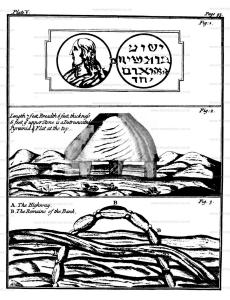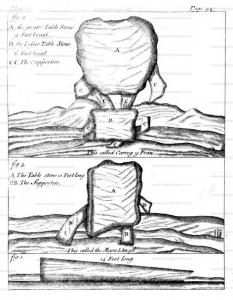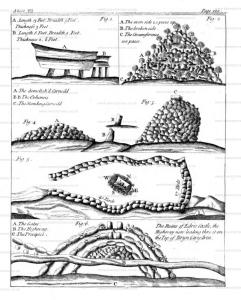Mona Antiqua Restauranta
Mona Antiqua Restauranta is in Prehistory.
Mona Antiqua Restauranta. An archæological discourse on the antiquities, natural and historical, of the isle of Anglesey, the ancient seat of the British druids. In two essays. With an appendix, containing a comparative table of primitive words, and the derivatives of them in several of the tongues of Europe; with remarks upon them. Together with some letters, and three catalogues. By Henry Rowlands, Vicar of LLanidan, in the Isle of Anglesey. The Second Edition, Corrected and Improved. Printed for J. Knox, near Southampton-Street in the Strand. MDCCLXVI.
Mona Antiqua Restauranta 93 Druidical Monuments
In the other townships likewise, and on the borders of them, there are to be seen either standing or thrown down, divers monuments of Druidish worship. There is a pretty Cromlech standing at the top of a hillock at Bodowyr [Map], fig. 2. There is also on arising part of the ground, there, the high-way leading through it, the remains of a small cirque,, fig. 3. And on another part of the ground there appear the marks of a Carnedd, the stones of which in times past have been dissposed of into walls and buildings.

There are near Llyslew Barn, in the same township, the tokens of a Carnedd; and a well-shaped pillar1 of great length, thrown flat on the ground. There is also a shapely Cromlech on the lands of Blochty in the township of Tre'r Beirdd, now thrown down and lying flat on its supporters, fig. 2. And not far from this last-mentioned, there appears another demolished Cromlech, now called Carreg-y-frân, which seems to have been a double one; the two larger incumbent flat stones, with many lesser supporters lying disorderly, leaning on one another, fig 3.
Note 1. See plate VI. fig. I.

There are also the ruins of a small Cromlech not far from the last mentioned at a place called Barras. A large demolished one at Tyddyn Cœfar, in the parish of Llan Edwen. Another ruined one at Rhôs y Cerrig, in Llanddeitniel parish. The remains of one near Carreg Wydrin. There are also up and down many remains of pillars and erected columns in all these precincts; some single, and some ranged in circles; most of them broken and cast down, probably by the conquering Romans, or by the zeal of succeeding Christians; to both of whom the vile cuftoms of the Druidish priests, and the appurtenances of their, barbarities, were equally hateful.
But of such Cromleche as remain yet undemolished, there is but one besides that at Bodowyr to be seen in all these precincts ; and that a very large one, before mentioned, slanding near Plâs newydd [Map], formerly Llwyn Moel, where it is probable one of their larger groves was. It is a double1 Cromlech, a larger and a smaller contiguous together. There is also at Plâs newydd wood one of the largest Carnedds in the Isle of Anglesey; yet scarce discerned and distinguished from a mount of earth, the stones being overgrown with earth and moss, and great trees growing thick upon it. It lies in a dry bottom, without any pillars now standing by it, fig. 2. There are also in Llanddaniel parish, at a place called formerly Llwyn Llwyd, now Bryn Kelli [Map], the remains of two Carnedds, within a few paces of one another; the one, fig. 3. is somewhat broken and pitted into on one side, where the stones have been carried away; the other, fig. 4. having had its stones almost all taken away into walls and buildings, with two standing columns erected between them.
Note 1. See plate VII. fig. I.

Mona Antiqua Restauranta 310 Letters
Worthy Sir, Sligo, March 12, 1699-1700.
I had not been so long silent, but for a reason I have mentioned this post to Mr. Bulkeley; for I was loth to trouble my friends till I had something to say that might seem worth communicating; and indeed one half of my time, since I left you, has been spent in places quite remote from all correspondence, amongst the Hebrides and other highlands of Scotland, with whom their neighbours seem to have left commerce than they have with either of the Indies. They are nothing so barbarous as the Lowlanders and English commonly represent them; but are, for what I could find, a very hospitable and civil people. And the main reasons of their contrary character I take to be their adhering too much to their ancient customs, habit and language; whereby they distinguish themselves fromi all their neighbours; and distinctions always create mutual reflections. I have filled about three sheets of paper with their customes (any or all whereof you may command at your leisure) and have translated Mr. Ray's Dictionariolum Trilingue into their language, which in two thirds, or thereabouts, agrees with ours. They have also the same sort of monuments we have, viz- Caer, Carn, Cromlech, and stones pitched on end circularly; agreeing sometimes exacty with ours, and sometimes a little varying from them. But as to the names of places,I know not whether the Lowlands of Scotland may not agree more with the British than the Highlands: as to instance in some names of their rivers.
[List of Scottish river names with English and Welsh equivalents.]
But indeed, most names of places throughout the kingdoms of Ireland and Scotland relish much of a British origin; though I suspect that upon a diligent comparison of the languages and customs, we shall find that the antient Scots of Ireland were distinct from the Britons of the same kingdom; but as yet I have not put my notes together, fo as to be satisfied herein.
We collected a confiderable number of inscriptions in Scotland, and some in this kingdom, both Latin and Irish. But I could meet with no antiquary, hitherto of either country, that could interpret those in the Irish. One monument I met with, within four miles of Edinburgh, different from all I had seen elsewhere, and never observed by their antiquaries. I take it to be the tomb of some Pictish king; though situate by a river-side, remote enough from any church. It is an area of about seven yards diameter, raised a-little above the rest of the ground, and encompassed with large stones; all which stones are laid lengthwise, excepting one larger than ordinary, which is pitched on end, and contains this inscription in the barbarous characters of the fourth and fifth centuries, In oc tumulo jacit Vetta F. Victi. This the common people call the Cat-Stene, whence I suspect the person's name was Getus, of which name I find three Pictish kings; for the names pronounced by the Britons with G were written in Latin with V as we find by Gwyrtheyrn, Gwyrthefyr and Gwythelyn, which were written in Latin Vortigernus, Vortimerus and Vitelinus.
I also met with one monument in this kingdom very singular. It stands at a place called New-Grange near Drogheda [Map]; and is a mount or barrow of very considerable height, encompassed with vast stones pitched on end round the bottom of it; and having another lesser standing on the top. This mount is all the work of hands, and consists almost wholly of stones; but is covered with gravel and green swerd, and has within it a remarkable cave. The entry into this cave is at bottom, and before it we found a great flat slone, like a large tombstone, placed edgewise, having on the outside certain barbarous carvings, like snakes encircled, but without heads. The entry was guarded all along on each side with such rude slones, pitched on end, some of them having the same carving, and other vast ones laid a-cross these at top. The out-pillars were so close pressed by the weight of the mount, that they admitted but just creeping in, but by degrees the passage grew wider and higher till we came to the cave, which was about five or fix yards high. The cave consists of three cells or apartments, one on each hand, and the third straight forward, and may be about seven yards over each way. In the right-hand cell stands a great bason of an irregular oval figure of one entire stone, having its brim oddly sinuated or elbowed in and out; and that bason in another of much the same form. Within this bason was some very clear water which dropped from the cave above, which made me imagine the use of this bason was for receiving such water, and that the use of the lower was to receive the water of the upper bason when full, for some sacred use, and therefore not to be spilled. In the left apartment there was such another bason, but single, neither was there any water in it. In the apartment straight forward there was no bason at all. Many of the pillars about the right-hand bafon were carved as the stones above-mentioned; but under feet there was nothing but loose stones of any size in confusion; and amongst them a great many bones of beads and some pieces of deers horns. Near the top of this mount they found a gold coin of the emperor Valentinian; but notwithstanding this, the rude carving above-mentioned makes me conclude this monument was never Roman, not to mention that we want history to prove that ever the Romans were at all in Ireland.
The druid doctrine about the Glain Neidr obtains very much throughout all Scotland, as well the Lowlands as Highlands; but there is never a word of it in this kingdom, where it seems, in regard there were no snakes, they could not propagate it. Besides the snake-stones (whereof I procured some variety in Scotland) the Highlanders have the snail-stones, paddoc-stones, mole-stones, hedgehog-stones, kock-knee-stones, elf-arrows, duel-stones &c to all which, they attribute their several virtues, and carry them about them as amulets. The Irish have many more ancient manuscripts than we in Wales; but since the late revolutions they are much lessened. I now and then pick up some very old parchment manuscripts but they are hard to come by, and they that do any thing understand them, value them as their lives. This province of Connaught abounds with figured foffils, but they are much the same with those in Wales, though several among them new. Wee have also met with some Alpine plants here that Britain no-where affords. At your leisure a few lines directed to be left with Mr. Richard Bulkeley, at the Blind-Key in Dublin will be exceeding acceptable to
Your most obliged humble Servant,
Edward Lhwyd.
Mona Antiqua Restauranta 319 Of the Bride Stones
Of the Bride Stones [Map].
To these Letters it may not be improper to add the following, which contains the description of an ancient Druidical monument, called the Bride Stones; and was communicated to us by the Rev. Mr. Thomas Malbon, rector of Congleton in Cheshire. It is not only curious in itself; but is nearly allied to the subject of this book, and serves to confirm some remarks which our author has made in the foregoing Essays.
The Bride Stones are in the parish of Biddulph in the county of Stafford; and sland on a rising ground in the break or opening between the Cloud and Woof-Lowe — which are two of the chain of hills that run through Staffordshire, Cheshire, Derbyshire, and Yorkshire, into Scotland.
A A, &c. * are fix upright, free stones, from three to fix feet broad, of various heights and shapes, fixed about six feet from each other in a semicircular form, and two within, where the earth is very black, mixed with ashes and oak-charcoal. It is apprehended the circle was originally complete, and twenty-seven feet in diameter; for there is the appearance of holes where stones have been, and also of two single stones, one standing East of the circle, at about five or six yards distance, and the other at the same disftance from that.
B B are rough, square, tapering stones, four feet three inches broad, and two feet thick. One on the North side is broken off, as is part of the other.
C C is the pavement of a kind of artificial cave. It is composed of broken pieces of stones about two inches and a half thick, and laid on pounded white stones about six inches deep; two inches of the upper part of which are singed with black, supposed from the ashes falling through the pavement, which was covered with them and oak-charcoal, about two inches thick. Several bits of bones were also found, but s small that it could not be discovered whether they were human or not.
The sides of this cave, if I may so call it, were originally composed of two unhewn free stones, about eighteen feet in length, fix in height, and fourteen inches thick at a medium. Each of them is now broken into two.
D is a partition slone slanding across the place, about five feet and a half high, and six inches thick. A circular hole is Cut through this stone, about nineteen inches and a half in diameter.
The whole was covered with long, unhewn, large, flat free ftones, since taken away. The height of the cave from the pavement to the covering is five feet and ten inches.
The entrance was filled up with free stones and earth, supposed to be dust blown by the wind from year to year in dry weather.
There remains another place of the same construction, but smaller, and without any inward partition, about fifty-five yards distant from this. It is two yards and a half long, two feet and a half broad, and three feet two inches high. There is also a part of another.
There was a large heap of stones that covered the whole, an hundred and twenty yards long, and twelve yards broad. These stones have been taken away from time to time by masons and other people, for various purposes. And in the year 1764, several hundred loads were carried away for making a turnpike-road about fixty yards from this place, which laid it open for examination.
This ancient sacred place was probably covered, says Mr. Malbon. with this great heap of stones to conceal and preserve it it the time the Druids were on the decline, But we rather think, as these Carnedde or heaps of stones were a general appurtenance of Druidical worship, that this, though of a different figure from these commonly known made a real part of the original structure.
